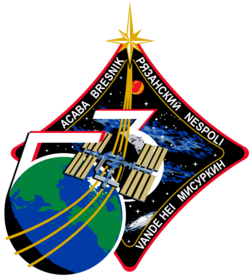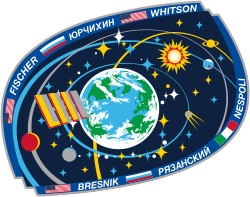Sergei Nikolajewitsch Rjasanski
| Sergei Rjasanski | |
|---|---|
 | |
| Land | Russland |
| Organisation | Roskosmos |
| Rufzeichen | Борей („Boreas“) |
| ausgewählt | 29. Mai 2003 |
| Einsätze | 2 Raumflüge |
| Start des ersten Raumflugs | 25. September 2013 |
| Landung des letzten Raumflugs | 14. Dezember 2017 |
| Zeit im Weltraum | 304d 23h 21min |
| EVA-Einsätze | 3 |
| EVA-Gesamtdauer | 20 h, 5 min |
| ausgeschieden | 16. Juli 2018 |
| Raumflüge | |
| |
Sergei Nikolajewitsch Rjasanski (russisch Серге́й Николаевич Рязанский; * 13. November 1974 in Moskau, UdSSR) ist ein ehemaliger russischer Kosmonaut.
Ausbildung
Rjasanskis Großvater Michail Rjasanski war als Funktechniker am sowjetischen Raumfahrtprogramm beteiligt. Rjasanski studierte ab 1991 an der virologisch-biologischen Fakultät der Lomonossow-Universität und schloss das Studium als Biochemiker 1996 ab. Danach begann er als Forscher am Institut für medizinisch-biologische Probleme (IMBP) des Staatlichen Wissenschaftlichen Zentrums (GNZ) zu arbeiten. Von März bis April 2000 war er Mitglied der siebten Mannschaft der SFINCSS (Simulation of Flight of International Crew on Space Station).[1] Im Jahr 2006 wurde er zum Ph.D. in Biologie promoviert.
Raumfahrer
Sergei Rjasanski wurde 2003 als Forschungs- und Testkosmonaut ausgewählt und absolvierte seine Grundausbildung vom 16. Juni 2003 bis zum 27. Juni 2005. Er wurde als Kommandant der Kosmonautengruppe des IMBP ausgewählt. Nach dem Verlassen des IMBP wurde er 2010 in die Kosmonautengruppe des Kosmonautentrainingszentrums transferiert.[1] 2009 nahm er an einer 105-Tage-Mission im Rahmen des Mars-500-Experiments teil.
Zu seinem ersten Raumflug startete Rjasanski am 25. September 2013 im Raumschiff Sojus TMA-10M zusammen mit Oleg Kotow und Michael Hopkins. Er arbeitete an Bord der Internationalen Raumstation als Bordingenieur der ISS-Expeditionen 37 und 38 und kehrte am 11. März 2014 zur Erde zurück. Im September 2015 wurde ihm der Titel Held der Russischen Föderation verliehen.[2]
Am 28. Juli 2017 startete Rjasanski zu seinem zweiten Einsatz. Als Kommandant des Raumschiffs Sojus MS-05 flog er zusammen mit dem Amerikaner Randolph Bresnik und dem Italiener Paolo Nespoli zur ISS. Dort arbeitete er als Bordingenieur der ISS-Expeditionen 52 und 53. Am 14. Dezember 2017 erfolgte der Rückflug zur Erde.
Siehe auch
Weblinks
- Kurzbiografie von Sergei Nikolajewitsch Rjasanski bei spacefacts.de
- Biografie von Sergei Nikolajewitsch Rjasanski beim Juri-Gagarin-Kosmonautentrainingszentrum (russisch)
- NASA-Biografie von Sergei Nikolajewitsch Rjasanski (Memento vom 1. August 2016 im Internet Archive)
Einzelnachweise
- ↑ a b Sergej Rjazanski. Spacefacts, 28. März 2012, abgerufen am 21. September 2013.
- ↑ Erlass des Präsidenten der Russischen Föderation vom 8. September 2015 N 451 „Über die Auszeichnung mit den staatlichen Auszeichnungen der Russischen Föderation“ (russisch)
| Personendaten | |
|---|---|
| NAME | Rjasanski, Sergei Nikolajewitsch |
| ALTERNATIVNAMEN | Рязанский, Серге́й Николаевич (russisch) |
| KURZBESCHREIBUNG | russischer Kosmonaut |
| GEBURTSDATUM | 13. November 1974 |
| GEBURTSORT | Moskau, RFSSR, UdSSR |
Auf dieser Seite verwendete Medien
The Expedition 53 crew insignia
- The International Space Station is our launch pad into the future of human space exploration. Collectively, our world stands at the cusp of incredible developments as a spacefaring species. Onboard the space station we continue to evolve the technologies vital to the sustainment and longevity of humans in the harsh realities of living without gravity or the protection of our atmosphere. These self-sustaining or regenerative technologies continually developed aboard the space station not only improve life here on Earth, but they are essential to human beings existence beyond low-Earth orbit (LEO).
- The space station is the linchpin for this next great phase of development and is instrumental in expanding the use of space, not only as a worldclass science laboratory, but also as a destination for next-generation space vehicles. This journey beyond LEO is depicted in the Expedition 53 patch as we, the crew, will endeavor to accomplish the work that allows future missions to further explore our solar system. This journey will only be accomplished as an international team, represented by our multinational crew as well as by the many countries depicted on the globe.
- The myriad of stars represent the untold number of passionate and supremely dedicated people that endeavor across the planet daily to make the space station the amazing vehicle it is as well as prepare us for the next great steps forward in space exploration.
Russian cosmonaut Sergey Ryzansky, Expedition 37/38 flight engineer, is pictured during an emergency scenario training session in the Space Vehicle Mock-up Facility at NASA's Johnson Space Center.
ISS Expedition 38 Patch
As the International Space Station (ISS) has become a stepping stone to future space exploration, the Expedition 38 mission patch design paints a visual roadmap of exploration beyond low Earth orbit, most prominently represented by the design's flowing Expedition 38 mission numbers that wrap around Earth, the moon and Mars. Just as the sun is a guiding light in the galaxy, the ISS illuminates the bottom of the design as it is a shining beacon of the advancement of science, knowledge, and technology carried out aboard the Space Station. To visually capture the idea of the ISS being a foundation for infinite discovery, the space station's iconic solar arrays span upwards, providing the number 38 and its exploration roadmap a symbolic pedestal to rest on. Finally, the overall use of red, white, and blue in the design acknowledges the flags of the countries of origin for Expedition 38's crew -- the United States, Russia, and Japan.
The Expedition 52 crew insignia
- Our planet is shown surrounded by an imaginary constellation shaped like a house, depicting the theme of the patch: “The Earth is our home.” It is our precious cradle, to be preserved for all future generations. The house of stars just touches the Moon, acknowledging the first steps we have already taken there, while Mars is not far away, just beyond the International Space Station, symbolized by the Roman numeral “LII,” signifying the expedition number.
- The planets Saturn and Jupiter, seen orbiting farther away, symbolize humanity’s exploration of deeper space, which will begin soon. A small Sputnik is seen circling the Earth on the same orbit with the ISS, bridging the beginning of our cosmic quest till now: Expedition 52 will launch in 2017, sixty years after that first satellite.
- Two groups of crew names signify the pair of Soyuz vehicles that will launch the astronauts of Expedition 52 to the Station.
Leonardo da Vincis vitruvianischer Mensch, erschaffen etwa vor 525 Jahren als eine Mischung aus Kunst und Wissenschaft sowie als Symbol des medizinischen Berufsstandes, wird zwischen den Umlaufbahnen einer Vielzahl von Satelliten dargestellt, die die Erde mit großer Geschwindigkeit umkreisen. Da Vincis Zeichnung, basierend auf den Proportionen eines Mannes, der vom römischen Architekten Vitruv beschrieben wurde, wird oft gebraucht als Symbol der Symmetrie des menschlichen Körpers und des Universums im Allgemeinen. Die nahezu perfekt symmetrische Internationale Raumstation mit ihren ausgebreiteten Sonnensegeln und beleuchtet von den ersten Strahlen des Sonnenaufgangs ist abgebildet als mächtiges Leuchtfeuer, welches sich aufwärts über unsere nächtlichen Horizonte bewegt als ultimatives Symbol von Wissenschaft und Technologie unseres Zeitalters. Sechs Sterne repräsentieren die sechs Mitglieder der Expedition-37-Crew, welche zwei Kosmonauten mit medizinischem Hintergrund, sowie einen Einheimischen aus Da Vincis Italien beinhaltet.




